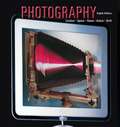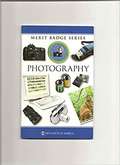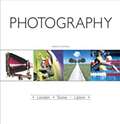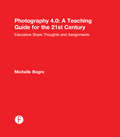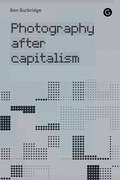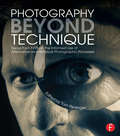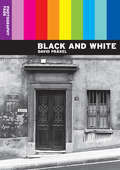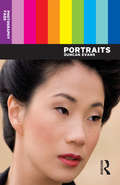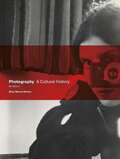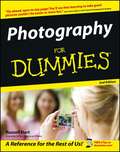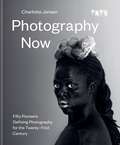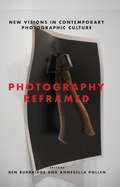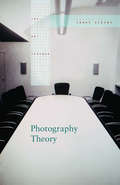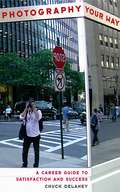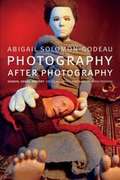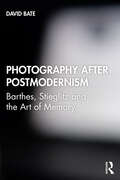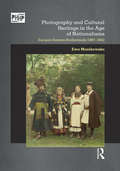- Table View
- List View
Photography (8th edition)
by John Upton Barbara London Jim Stone Ken Kobré Betsy BrillThe now venerable textbook continues its double focus on technique and visual awareness, updating the technical aspects to include the digital dimension infiltrating the profession, and placing more emphasis of ways to improve visual awareness. Auxiliary material includes an instructor's manual, a student laboratory manual and journal, and an interactive Web site. Annotation C. Book News, Inc., Portland, OR (booknews.com)
Photography (Merit Badge Series)
by Boy Scouts of America StaffOutlines requirements for pursuing a merit badge in photography and examines such topics as making good photographs, cameras and how they work, film versus digital, telling stories with pictures, illustrating a topic or theme with pictures, a career in photography, and photography resources.
Photography (Merit Badge)
by Boy Scouts of AmericaOutlines requirements for pursuing a merit badge in photography and examines such topics as making good photographs, cameras and how they work, film versus digital, telling stories with pictures, illustrating a topic or theme with pictures, a career in photography, and photography resources.
Photography (Myphotographykit Ser.)
by John Upton Barbara London Jim StoneThis best-selling introductory photography text teaches students how to use the medium confidently and effectively by emphasizing both technique and visual awareness. Comprehensive in scope, this book features superb instructional illustrations and examples in its clear presentation of both black and white and color photography. London offers extensive coverage of digital imaging and the latest technological developments, such as Web page design and formatting photos on CD-ROMs.
Photography 4.0: Educators Share Thoughts and Assignments (Photography Educators Series)
by Michelle BogreAn invaluable resource for photography educators, this volume is a survey of photographic education in the first decade of the 21st Century. Drawing upon her 25 years of teaching experience and her professional network, Michelle Bogre spoke with 47 photo educators from all over the world to compile this diverse set of interviews. The themes of these conversations explore: Why students should study photography The value of a formal photography degree Teaching philosophies Whether video and multimedia should be an essential part of a photographic curricula The challenges of teaching photography today Changes in photographic education overall The second half of the book shares 70 photography assignments of varying level of difficulty from these educators, some paired with examples of how students completed them. This book will inspire and invigorate any photography educator’s curriculum.
Photography After Capitalism
by Ben BurbridgeA lively and polemical analysis of photography and today's vernacular photographic culture.In Photography After Capitalism, Benedict Burbridge makes the case for a radically expanded conception of photography, encompassing the types of labor too often obscured by black-boxed technologies, slick platform interfaces, and the compulsion to display lives to others. His lively and polemical analysis of today's vernacular photographic cultures shines new light on the hidden work of smartphone assembly teams, digital content moderators, Street View car drivers, Google "Scan-Ops,"low-paid gallery interns, homeless participant photographers, and the photo-sharing masses.
Photography Beyond Technique: Essays From F295 On The Informed Use Of Alternative And Historical Photographic Processes (Alternative Process Photography)
by Tom PersingerPhotography is not dying and has not died. It has been an ever-changing medium since its earliest days, and while near-obsession with the technology of the day may have defined photography over the course of its existence, photography is so much more than hardware and software. Photography is communication, whether chemical or digital, tangible or ephemeral in form. Photography Beyond Technique is a compelling selection of essays and images that reveal the thoughts and methods of some of today’s most exciting contemporary photographers. These artists employ alternative, historical, or handmade processes and techniques, and they share a comprehensive view of the medium: that the choice of photographic process is just as important as the selection of subjects. While other books concentrate solely on process, or theory, or artistic intent, none focus on photography in which these decisions are considered inseparable. These 20 essays, originally presented at the annual F295 symposium and seminar series, provide a thought-provoking read for anyone interested in photography as an art form and as a medium through which to view the world. Includes: "Looking Backward, Seeing Forward: Reframing Visual History" by Robert Hirsch "Mystery, Memory, and Narrative" by Martha Casanave "Finding Confidence: Combining Process with Purpose" by Mark Osterman "Photograph, Material, and Metaphor" by Jerry Spagnoli
Photography Careers: Finding Your True Path
by Mark JenkinsonPhotography Careers offers students an indispensable guide to beginning their professional journeys as photographers. This book presents the variety of career options available to those entering the competitive and comprehensive world of photography. With the insight and advice from industry mavens and the author himself, Photography Careers will help you change the way you evaluate your strengths as an artist and find your place in the photography community. Features include: Interviews with successful young professional photographer in a wide range of photographic specialties, from fashion photography to cinematography, and other industry related fields such as retouching, fine art sales, and photo editing Tips for how to find unique approaches in a saturated market Best practices for student looking at graduate programs, a budding career, and as a personal business
Photography Essentials: Waiting for the Light (Photography Essentials)
by David NotonWaiting for the Light is a breathtaking visual celebration of award-winning landscape photographer David Noton's work to date. A long-awaited exploration of David's images, this book showcases the very best from his extensive portfolio, with photographs from every continent.David offers amateurs and professionals alike the opportunity to learn about his techniques and equipment, and find out how to achieve similar results in their own work. The book also includes an invaluable chapter exploring the incorporation of digital techniques. Beautiful images combined with explanatory captions and practical, revealing text, make this an indispensable must-have for any photographer.
Photography FAQs: Black and White
by David PräkelPhotography FAQs: Black and White covers every aspect of black & white photography, from capturing the image to filtration, to developing and printing an image and successful presentation.The title offers detailed responses to the key, reader-defined questions drawn from photographic workshops, consumer press and internet forums, and, as such, is an invaluable and handy reference.The Photography FAQs series is a comprehensive, pocket-size reference for the amateur photographer in the field (or the studio). Each title is formulated as an encyclopaedia of 50 questions and answers covering every aspect of the key photography subjects that come up again and again, including genres such as landscape, portraiture and travel and shooting in monochrome. Each topic is supported by lively, accessible text, inspirational images and clear, easy-to-navigate design that makes this series a quick-and easy reference.
Photography FAQs: Fully Updated For Cs4 (Photography Faqs Ser.)
by Duncan EvansPhotography FAQs: Portraits is an introduction to the school of photography concerned with the most engaging of subjects: other people.Formulated as an encyclopaedia of questions and answers across 50 topics, this book covers every aspect of portrait photography, from hardware to lighting, composition to software.It offers detailed responses to key, reader-defined questions drawn from photographic workshops, consumer press and Internet forums. As such, it is an invaluable and handy reference.The Photography FAQs series is a comprehensive, pocket-size reference for the amateur photographer in the field (or the studio). Each title is formulated as an encyclopaedia of 50 questions and answers covering every aspect of the key photography subjects that come up again and again, including genres such as landscape, portraiture and travel and shooting in monochrome. Each topic is supported by lively, accessible text, inspirational images and clear, easy-to-navigate design that makes this series a quick-and easy reference.
Photography Fifth Edition: A Cultural History (Perspectives On Photography Ser.)
by Mary Warner MarienThe fifth edition of this indispensable history of photography spans the history of the medium, from its early development to current practice, and providing a focused understanding of the cultural contexts in which photographers have lived and worked throughout, this remains an all-encompassing survey.Mary Warner Marien discusses photography from around the world and through the lenses of art, science, travel, war, fashion, the mass media and individual photographers. Professional, amateur and art photographers are all represented, with 'Portrait' boxes devoted to highlighting important individuals and 'Focus' boxes charting particular cultural debates. Mary Warner Marien is also the author of 100 Ideas that Changed Photography and Photography Visionaries.New additions to this ground-breaking global survey of photography includes 20 new images and sections on advances in technology and the influence of social media platforms. An essential text for anyone studying photography.
Photography Fifth Edition: A Cultural History (Perspectives On Photography Ser.)
by Mary Warner MarienThe fifth edition of this indispensable history of photography spans the history of the medium, from its early development to current practice, and providing a focused understanding of the cultural contexts in which photographers have lived and worked throughout, this remains an all-encompassing survey.Mary Warner Marien discusses photography from around the world and through the lenses of art, science, travel, war, fashion, the mass media and individual photographers. Professional, amateur and art photographers are all represented, with 'Portrait' boxes devoted to highlighting important individuals and 'Focus' boxes charting particular cultural debates. Mary Warner Marien is also the author of 100 Ideas that Changed Photography and Photography Visionaries.New additions to this ground-breaking global survey of photography includes 20 new images and sections on advances in technology and the influence of social media platforms. An essential text for anyone studying photography.
Photography For Dummies
by Russell HartYour personal photographs have a worth that can't be measured in dollars and cents. They're likely the one thing you would grab on the way out of a burning house - an irreplaceable record of the life you lead, of friends and family, and of the occasions with which you mark passing years. The funny thing is, most people aren't entirely happy with their photographs. And that's where Photography For Dummies comes in. You don't need a fancy camera with multiple, removable lenses to get good pictures. The problem is, nearly every book on photography assumes that you're using one. But this book assumes that you're using a point-and-shoot camera for all your pictures. In fact, this may be the most complete guide available for taking pictures with a modern point-and-shoot camera. This revised edition of Photography For Dummies helps you choose film (much simpler than you'd think), load film into the camera (no big sweat), and understand how to hold the camera (yes, there are right and wrong ways). You'll also discover tips about dealing with your photofinisher - a far more important factor in getting good results than most people realize, especially in the digital age. What's more, you'll gain insight into Working with your camera, and how different settings make your camera do different things Understanding the importance of light in a photograph, and applying design strategies that make your subjects stand out Getting shots that both flatter people and capture their personalities Shooting landscapes, and the special considerations of travel photography Taking pictures filmlessly, and the pleasures and pitfalls of digital photography Troubleshooting your camera, and discovering what do try if it won't shoot Today's point-and-shoot cameras are remarkably reliable devices. So why aren't your pictures better? The main secret to better photographs is knowing what to shoot, when to shoot it, and how to shoot it. You need Photography For Dummies, because it lets you in on this secret.
Photography Now: Fifty Pioneers Defining Photography for the Twenty-First Century
by Charlotte JansenIn the last century, photography was always novel. Now, it feels like our world is over-saturated with images. In the 21st century, what can photography do that is new?This extensively illustrated survey answers that question, presenting fifty photographers from around the world who are defining photography today. Their styles, formats, and interpretations of the medium vary widely, but in each case, the work featured in this book represents photography doing what it has always done best: finding new ways to tell stories, and new stories to tell.Artists featured include Nan Goldin, Wolfgang Tillmans, Hassan Hajjaj, Andreas Gursky, Juno Calypso, Ryan McGinley, Zanele Muholi, Shirin Neshat, Catherine Opie, Martin Parr, Cindy Sherman, Hiroshi Sugimoto and Juergen Teller.
Photography Now: Fifty Pioneers Defining Photography for the Twenty-First Century
by Charlotte JansenIn the last century, photography was always novel. Now, it feels like our world is over-saturated with images. In the 21st century, what can photography do that is new?This extensively illustrated survey answers that question, presenting fifty photographers from around the world who are defining photography today. Their styles, formats, and interpretations of the medium vary widely, but in each case, the work featured in this book represents photography doing what it has always done best: finding new ways to tell stories, and new stories to tell.Artists featured include Nan Goldin, Wolfgang Tillmans, Hassan Hajjaj, Andreas Gursky, Juno Calypso, Ryan McGinley, Zanele Muholi, Shirin Neshat, Catherine Opie, Martin Parr, Cindy Sherman, Hiroshi Sugimoto and Juergen Teller.
Photography Reframed: New Visions in Contemporary Photographic Culture (International Library Of Visual Culture Ser.)
by Ben BurbridgeAt a critical point in the development of photography, this book offers an engaging, detailed and far-reaching examination of the key issues that are defining contemporary photographic culture. Photography Reframed addresses the impact of radical technological, social and political change across a diverse set of photographic territories: the ontology of photography; the impact of mass photographic practice; the public display of intimate life; the current state of documentary, and the political possibilities of photographic culture. These lively, accessible essays by some of the best writers in photography together go deep into the most up-to-date frameworks for analysing and understanding photographic culture and shedding light on its histories. Photography Reframed is a vital road map for anyone interested in what photography has been, what it has become, and where it is going.
Photography Second Edition (Portfolio)
by John IngledewA complete introduction to photography, this book is an essential resource for students across the visual arts. This accessible, inspirational guide explores the subjects and themes that have always obsessed photographers and explains technique in a clear and simple way. It introduces the work of the masters of the art as well as showing fresh, dynamic images created by young photographers from all over the world. The book also provides a valuable overview of careers in photography and a comprehensive reference section, including a glossary of technical vocabulary. This second edition has been extensively updated, with a greater range of visual examples from master photographers and up-to-date information on digital photography.
Photography Second edition: A Complete Guide To Photography (Portfolio Ser.)
by John IngledewA complete introduction to photography, this book is an essential resource for students across the visual arts. This accessible, inspirational guide explores the subjects and themes that have always obsessed photographers and explains technique in a clear and simple way. It introduces the work of the masters of the art as well as showing fresh, dynamic images created by young photographers from all over the world. The book also provides a valuable overview of careers in photography and a comprehensive reference section, including a glossary of technical vocabulary. This second edition has been extensively updated, with a greater range of visual examples from master photographers and up-to-date information on digital photography.
Photography Theory (The Art Seminar)
by Jame ElkinsPhotography Theory presents forty of the world's most active art historians and theorists, including Victor Burgin, Joel Snyder, Rosalind Krauss, Alan Trachtenberg, Geoffrey Batchen, Carol Squiers, Margaret Iversen and Abigail Solomon-Godeau in animated debate on the nature of photography. Photography has been around for nearly two centuries, but we are no closer to understanding what it is. For some people, a photograph is an optically accurate impression of the world, for others, it is mainly a way of remembering people and places. Some view it as a sign of bourgeois life, a kind of addiction of the middle class, whilst others see it as a troublesome interloper that has confused people's ideas of reality and fine art to the point that they have difficulty even defining what a photograph is. For some, the whole question of finding photography's nature is itself misguided from the beginning. This provocative second volume in the Routledge The Art Seminar series presents not one but many answers to the question what makes a photograph a photograph?
Photography Your Way: A Career Guide to Satisfaction and Success
by Chuck DelaneyThis book gives you straight-talking advice from a pro on how to build a successful career in photography, said PhotoSource International of the first edition of Photography Your Way. Now distinguished author Chuck DeLaney has updated this classic book to show how digital has increased the power of photography and broadened the options open to anyone who wants a career as a photographer. Rich with seasoned advice and practical tools for developing an individual style, this book is essential for emerging photographers.
Photography after Photography: Gender, Genre, History
by Abigail Solomon-Godeau Sarah ParsonsPresenting two decades of work by Abigail Solomon-Godeau, Photography after Photography is an inquiry into the circuits of power that shape photographic practice, criticism, and historiography. As the boundaries that separate photography from other forms of artistic production are increasingly fluid, Solomon-Godeau, a pioneering feminist and politically engaged critic, argues that the relationships between photography, culture, gender, and power demand renewed attention. In her analyses of the photographic production of Cindy Sherman, Robert Mapplethorpe, Susan Meiselas, Francesca Woodman, and others, Solomon-Godeau refigures the disciplinary object of photography by considering these practices through an examination of the determinations of genre and gender as these shape the relations between photographers, their images, and their viewers. Among her subjects are the 2006 Abu Ghraib prison photographs and the Cold War-era exhibition The Family of Man, insofar as these illustrate photography's embeddedness in social relations, viewing relations, and ideological formations.
Photography after Postmodernism: Barthes, Stieglitz and the Art of Memory
by David BateIn life after postmodernism our conception of photography is not the same as before. Photography After Postmodernism starts with this conception and explores what changes have affected photography, its relation to social life and our image-centred culture. Engaging with the visual environment and issues that have emerged in the postmodern world, David Bate introduces fresh approaches and analysis of photographs and their place within the aftermath of postmodernist thought. The book shows how photographs circulate in an 'image-world' beyond their art or media origins that deeply affects our sense of time and relation to memory. The role of archives, dreams, memories and time are deployed to develop and resituate arguments about photography made by Roland Barthes in Camera Lucida to further engage and understand our contemporary condition. By considering how ‘afterwardness’ is invoked in the developments of modern and contemporary photography, Bate demonstrates the complex ways in which photographic images resonate across public and private spaces, while carrying a slippage of meaning that is never quite fixed, yet always contingent and social. The approach shows how modernist photography was already invested in values that its discourse could not enunciate, which resonates with much contemporary photography today. Featuring a range of historical and contemporary images, the book offers detailed and innovative readings of specific photographs which open new avenues of thought for those studying and researching visual culture and photography.
Photography and Collaboration: From Conceptual Art to Crowdsourcing
by Daniel PalmerPhotography and Collaboration offers a fresh perspective on existing debates in art photography and on the act of photography in general. Unlike conventional accounts that celebrate individual photographers and their personal visions, this book investigates the idea that authorship in photography is often more complex and multiple than we imagine – involving not only various forms of partnership between photographers, but also an astonishing array of relationships with photographed subjects and viewers. Thematic chapters explore the increasing prevalence of collaborative approaches to photography among a broad range of international artists – from conceptual practices in the 1960s to the most recent digital manifestations. Positioning contemporary work in a broader historical and theoretical context, the book reveals that collaboration is an overlooked but essential dimension of the medium’s development and potential.
Photography and Cultural Heritage in the Age of Nationalisms: Europe's Eastern Borderlands (1867�1945) (Photography, History: History, Photography)
by Ewa ManikowskaThe second half of the 19th century was a time of extensive political upheaval in central east Europe that saw the negotiation of conflicting territorial claims in the region by the Russian, Austrian and Prussian empires. The post-WW1 settlement gave rise to the formation of the independent nation states of Poland, Lithuania, Ukraine, Latvia and Belarus. Less well know is that this same period was also an era of keen photographic activity. During this time of empire-, state- and nation-building, cultural heritage was a potent vehicle and a provider of collective memory and identity.This innovative account analyses the relationship between politics, history, cultural heritage and photography in central east Europe between 1859 and 1945. To understand the work photographs ‘do’ in the construction of cultural heritage, the author analyses a wide range of little-known photographic archives created by contemporary professional and amateur photographers. Their work was extensively exploited in contemporary debates, appearing in albums, books, journals, exhibitions, museum exhibits, postcards and newspapers aimed at both scientific and popular and national and international publics. An extensive analysis of how photographic practices and outcomes were applied, borrowed, copied, appropriated and transmitted shows how photography was used to exert or subvert power, on the one hand, and as a tool in constructing and negotiating group identities on the other. By weaving photography and its patterns of making, dissemination and archival survival through major historical narratives, this volume reveals the centrality of photography and visual discourse at pivotal moments of modern history.
